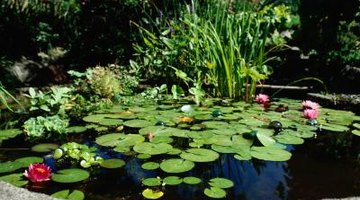How to Glue PVC Pond Liners
PVC, poly vinyl chloride, has become the liner of choice for ponds and fountains. It is extremely flexible, waterproof, and inexpensive. Using PVC liners to line the inside of your pond ensures a perfect fit and keeps all of its elements from permeating into the ground that surrounds it. Although they have a higher risk of tearing than concrete liners since they are plastic-based, they can be easily fixed.

Step 1
Drain the pond water, and remove any fish or plants before you clean and line the pond.
Step 2
Soak the rag in water, and begin scrubbing the pond after all of its elements have been removed. Algae is one of the most common inhabitants of ponds, and it should slide right off the walls or floor of the pond when you scrub it.
Step 3
Pour in some dry salt. This will help assist in the breakup of any algae you were unable to remove with the rag.
Step 4
Use the hair dryer, or any other heated source, to dry out the pond completely.
Step 5
Apply a coat of contact cement around the inside of the pond and then a coat on the back of the PVC liner.
Step 6
Heat the cement on the liner so that it welds more easily with the cement on the pond walls and floor. Do not overheat to the point where you cannot hold the PVC in your hands.
Step 7
Apply the liner to the pond, rubbing around it to make sure it is glued on tightly. Applying more pressure will help ensure that no air bubbles are present between the liner and the pond walls.
References
Writer Bio
Joshua Bailey resides in Pennsylvania and has been a professional writer since 2007. His writing focuses on topics in film, entertainment, music and religion. Bailey has been published on eHow and has written numerous articles for three universities. He holds a Bachelor of Arts in business and creative writing from Moravian College.
Photo Credits
- Ryan McVay/Photodisc/Getty Images
More Articles



